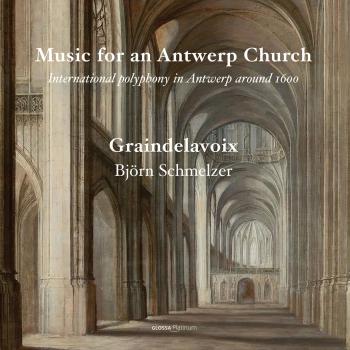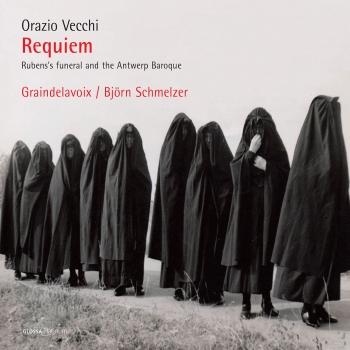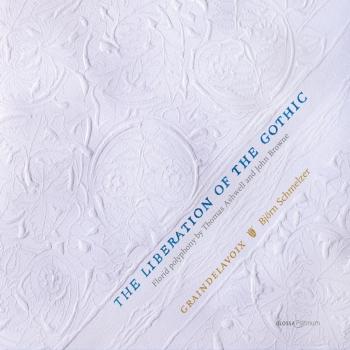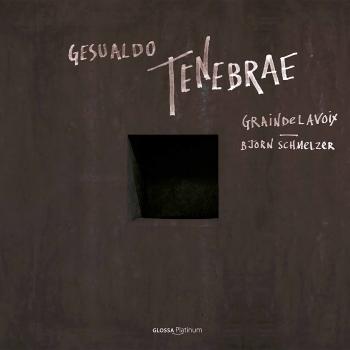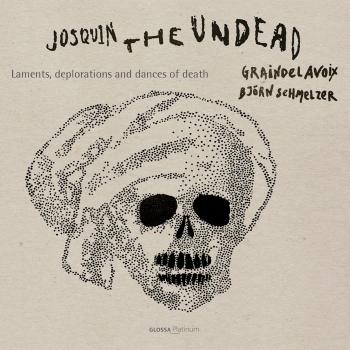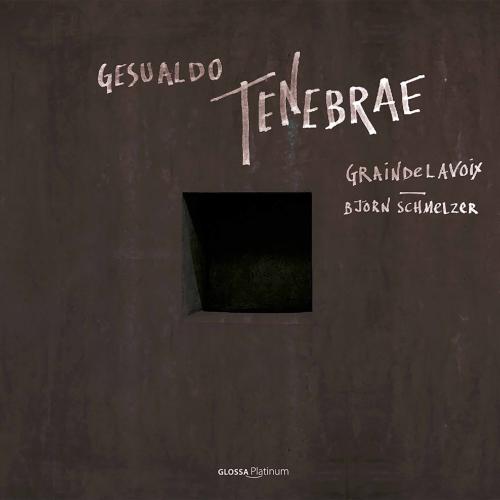
Tenebrae Graindelavoix & Björn Schmelzer
Album Info
Album Veröffentlichung:
2020
HRA-Veröffentlichung:
17.04.2020
Label: Glossa
Genre: Classical
Subgenre: Vocal
Interpret: Graindelavoix & Björn Schmelzer
Komponist: Carlo Gesualdo (1566-1613)
Das Album enthält Albumcover Booklet (PDF)
- Carlo Gesualdo (1566 - 1613): Feria Quinta – Tenebrae Responsoria for Maundy Thursday:
- 1 Aleph. Quomodo sedet sola civitas 03:33
- 2 Tenebrae responsoria for Maundy Thursday: No. 1, In monte Oliveti 05:01
- 3 Zain. Recordata est Hierusalem 03:45
- 4 Tenebrae responsoria for Maundy Thursday: No. 2, Tristis est anima mea 05:09
- 5 Lamed. O vos omnes, qui transitis per viam 02:41
- 6 Tenebrae responsoria for Maundy Thursday: No. 3, Ecce vidimus eum 08:08
- 7 Exaudi, Deus, orationem meam 02:39
- 8 Tenebrae responsoria for Maundy Thursday: No. 4, Amicus meus 03:39
- 9 Tenebrae responsoria for Maundy Thursday: No. 5, Iudas mercator pessimus 02:13
- 10 Tenebrae responsoria for Maundy Thursday: No. 6, Unus ex discipulis meis 06:15
- 11 Tenebrae responsoria for Maundy Thursday: No. 7, Eram quasi agnus 05:55
- 12 Tenebrae responsoria for Maundy Thursday: No. 8, Una hora 03:31
- 13 Tenebrae responsoria for Maundy Thursday: No. 9, Seniores populi 05:53
- 14 Christus factus est 02:38
- 15 Tenebrae responsoria: Miserere mei Deus 10:13
- Feria Sexta – Tenebrae Responsoria for Good Friday:
- 16 Heth. Cogitavit Dominus dissipare 03:19
- 17 Tenebrae responsoria for Holy Friday: No. 1, Omnes amici mei 05:01
- 18 Lamed. Matribus suis dixerunt 03:09
- 19 Tenebrae responsoria for Holy Friday: No. 2, Velum templi scissum est 04:41
- 20 Aleph. Ego vir videns paupertatem 04:42
- 21 Tenebrae responsoria for Holy Friday: No. 3, Vinea mea electa 05:37
- 22 Tenebrae responsoria for Holy Friday: No. 4, Tamquam ad latronem 03:44
- 23 Tenebrae responsoria for Holy Friday: No. 5, Tenebrae factae sunt 05:53
- 24 Tenebrae responsoria for Holy Friday: No. 6, Animam meam dilectam tradidi 08:31
- 25 Tenebrae responsoria for Holy Friday: No. 7, Tradiderunt me in manus impiorum 03:17
- 26 Tenebrae responsoria for Holy Friday: No. 8, Iesum tradidit impius 04:57
- 27 Tenebrae responsoria for Holy Friday: No. 9, Caligaverunt oculi mei 10:00
- Sabbato Sancto – Tenebrae Responsoria for Holy Saturday:
- 28 Heth. Misericordiae Domini 02:52
- 29 Tenebrae responsoria for Holy Saturday: No. 1, Sicut ovis ad occisionem 03:31
- 30 Aleph. Quomodo obscuratum est aurum 02:23
- 31 Tenebrae responsoria for Holy Saturday: No. 2, Hierusalem, iuge et exue te 04:21
- 32 Incipit oratio Hieremiae Prophetae 03:41
- 33 Tenebrae responsoria for Holy Saturday: No. 3, Plange quasi virgo 07:09
- 34 Tenebrae responsoria for Holy Saturday: No. 4, Recessit Pastor noster 04:02
- 35 Tenebrae responsoria for Holy Saturday: No. 5, O vos omnes 04:39
- 36 Tenebrae responsoria for Holy Saturday: No. 6, Ecce quomodo moritur justus 05:52
- 37 Tenebrae responsoria for Holy Saturday: No. 7, Astiterunt reges terrae 02:40
- 38 Tenebrae responsoria for Holy Saturday: No. 8, Aestimatus sum 03:45
- 39 Tenebrae responsoria for Holy Saturday: No. 9, Sepulto Domino 06:25
- 40 Mulieres sedentes (1) 00:49
- 41 Tenebrae responsoria: Benedictus Dominus Deus Israel 06:53
- 42 Mulieres sedentes (2) 00:50
Info zu Tenebrae
Es gibt etwas zutiefst Beunruhigendes und Unergründliches in Gesualdos Musik, etwas, dem sich jeder Zuhörer, selbst der unerfahrenste, nicht entziehen kann. Dies gilt insbesondere für die Tenebrae Responsoria (1611), seine finale Aussage, sein Denkmal, sein Vermächtnis. Es wirkt so, als ob dieses Werk, das fest in den liturgischen Rahmen der Karwoche eingebunden ist und auf die Praktiken des gregorianischen Gesangs zurückgreift, sich ständig über seine Grenzen hinaus ausdehnen und seine Zeit und seinen Rahmen sprengen wur̈ de, indem es unmittelbar Bezug auf die Moderne nimmt, in einer gewaltigen Spannung sämtliche Regeln durchbricht. Das Werk dringt in einen Bereich vor, der an Chaos und Wahnsinn grenzt, und zwar innerhalb der OrdnungundderreligiösenAndacht,fur̈ diees uneingeschränkt steht.
Graindelavoix, dieses bahnbrechende Ensemble mit Sitz in Antwerpen und unter der Leitung von Björn Schmelzer, sind die idealen Interpreten für dieses beunruhigende Repertoire, das ursprünglich im Schloss von Gesualdo und mit wahrscheinlich nur einem Zuhörer im Publikum gesungen wurde: Gesualdo selbst... In einer über dreistündigen Tour de Force, die im Sommer 2019 an zehn Tagen aufgenommen wurde, zeigen die Sängerinnen und Sänger alle Merkmale, die ihren Klang nach 16 Alben (alle auf Glossa) und Hunderten von Konzerten zu einem echten Markenzeichen gemacht haben. In Worten Schmelzers: »Dies ist unsere bisher wichtigste Aufnahme«. Ein faszinierender Essay des slovenischen Philosophen und Kulturtheoretiker Mladen Dólar stellt die Musik von Gesualdo in den Kontext seiner Zeit und vermeidet die Klischees, die so oft in Texten über den Komponisten zu finden sind.
Graindelavoix
Björn Schmelzer, Leitung
Graindelavoix
is much less an early music ensemble and much more an art collective experimenting between the fields of performance and creation, comprising singers and instrumentalists led by Björn Schmelzer. Taking its name from an essay by Roland Barthes (“le grain, c’est le corps dans la voix qui chante, dans la main qui écrit, dans le membre qui exécute...”), where Barthes was looking for what constitutes the gritty essence of a voice, Graindelavoix experiments with what one does with the “grain”, the physical and spiritual reflection of the voice.
Formed in 1999 by Schmelzer and based in Antwerp in Belgium, the collective works with material as diverse as Ockeghem’s polyphony, the plainte, machicotage, Mediterranean practices, late scholastic dynamics and kinematics, the affective body, gesture and image culture... What is preoccupying Graindelavoix in early music is the bond between notation and what eludes it: the higher consciousness and savoir-faire that the performer brings to a piece (ornamentation, improvisation, gestures...). Schmelzer works with singers and instrumentalists who embrace diversity, heterogeneity, ornamentation and improvisation in their music-making. In many ways, an ethno-musicological approach to early music.
Graindelavoix is a “special guest” at the Muziekcentrum De Bijloke in Ghent and has an artistic partnership with the Cultuurcentrum in the further Belgian city of Genk.
In Poissance d’amours Schmelzer – an ethnomusicologist by training – explores the music and writings of mystics, monks and minstrels active in 13th century Brabant for Glossa. This release and the recordings of music composed by Johannes Ockeghem (Caput) and Gilles Binchois (Joye) are allied to performances – in concert and music theatre formats – that are the accumulated fragments of a wider work and research process. Graindelavoix is offering a challenging new insight into the performances of music from the past.
Björn Schmelzer
studied anthropology and musicology but as a multidisciplinary artist he is primarily self-taught. He is the founder and artistic director of graindelavoix, an artist company that starts from folds and faults in ancient repertoires to rehabilitate the fundamental anachronism of practices in time. From this point of view, graindelavoix brings together artists of all disciplines: musical, visual and performative…Over the course of long research stays, Schmelzer studied primarily in the Mediterranean world, in Italy (Sardinia, Sicily), Spain, Portugal and Morocco, specializing in vocal repertoire and performance practice. He studied several medieval vocal traditions in depth, their continuation and survival in later times, ornamentation styles, and the logic of operative knowledge. He combines this work with insights from anthropology, history, human geography and ethnomusicology, resulting in various publications and concert programs. He is regularly requested as a guest conductor and lecturer. Björn Schmelzer has published several essays and articles for literary magazines, specialized magazines, academic publications and exhaustive CD booklets. He is currently writing a book about vocal practices, derived from 10 years of expertise with graindelavoix. With graindelavoix he has received several prizes and awards such as 'Young Musician of the Year' by the Belgian Music Press.
In 2011, Schmelzer became the first "Creative Fellow in Musicology", a collaboration between the Utrecht Early Music Festival and the Centre for Humanities at Utrecht University. Besides his activities as artistic director of graindelavoix, he makes films, both fictional and documentary, often associated with graindelavoix projects. As a playwright and director, he created, among others, Cesena with Anne Teresa de Keersmaeker, Muntagna Nera with Filip Jordens and Jan Van Outryve, Ossuaires with Koen Broos and Wim Scheyltjens and Trabe Dich Thierlein! with Margarida Garcia, Koen Broos and David Hernandez. Most recently, he designed audio-visual and interdisciplinary installations with Koen Broos and Margarida Garcia in The Hospital of Undersized Gestures.
Booklet für Tenebrae









